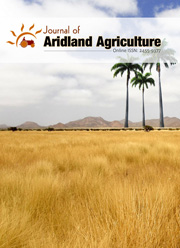Effect of cutting position and vine pruning level on yield of Sweet Potato (Ipomoea Batatas L.)
DOI:
https://doi.org/10.25081/jaa.2019.v5.5255Keywords:
Sweet potato (Ipomoea batatas L.), cutting position, vine pruning, storage root, yield.Abstract
There is significant variation in yield of storage roots and vines of sweet potato (Ipomoea batatas) among farmers due to use of different cutting positions and pruning of vines at different levels. This study was carried out to establish the cutting position and the vine pruning level that give the best yield of both the storage roots and vines. The study was conducted in a 3x3 factorial arrangement in Randomized Complete Block Design (RCBD) with three replications. Treatments included cutting position at three levels (apical cutting, middle cutting and basal cutting) and pruning at three levels, 0%, 25% and 50% respectively. Pruning was done. 50 days after planting. And storage root harvesting was done 100 days after planting. The two measurements were summed up to give the total vine weight. Storage root length, diameter and weight were measured at 100 DAP. Storage root length indicated significant difference (P<0.05) only among cutting positions with highest mean length (16.20 cm) obtained from apical cutting and the lowest (11.98 cm) from basal cutting. Storage root diameter, storage root weight and vine weight indicated significant interaction (P<0.05) of cutting position and vine pruning level. Highest mean root diameter and root weight were obtained from middle cutting and 25% vine pruning level, with the lowest being obtained from basal cutting and 50% vine pruning level. Highest vine weight was recorded from middle cutting and 50% vine pruning level, with the lowest being recorded from basal cutting and 0% vine pruning level. Both middle and apical stem cuttings can be recommended for higher storage root and vine yield. Vine pruning at 25% can be adopted for higher storage root yield while pruning at 50% can be suggested for higher vine yield.
Downloads
References
[2] Belehu T, Hammes PS. Effect of temperature, soil moisture content and type of cutting on establishment of sweet potato cuttings. South African Journal of Plant and Soil. 2004 21(2):85-9.
[3] Chagonda I, Mapfeka RF, Chitata T. Effect of tillage systems and vine orientation on yield of sweet potato (Ipomoea batatas L.). American Journal of Plant Sciences. 2014;5:3159-3165.
[4] Nedunchezhiyan M, Gangadharan B, Susantha K. Sweet Potato Agronomy. Fruit, vegetable, cereal science and biotechnology. Global Science Books. 2012;6(1):1-10.
[5] Mutandwa E. Performance of tissue-cultured sweet potatoes among smallholder farmers in Zimbabwe. The Journal of Agrobiotechnology Management and Economics. 2008;11(1)5:48-57.
[6] Toshome-Abdissa M, Nigussie-Dechassa R. Yield and yield component of sweet potato as affected by farmyard manure and phosphorus application: in the case of Adami Tulu District, Central Rift Valley of Ethiopia. Basic Research Journal of Agricultre Science and Review. 2012;1(2):31-42
[7] Mutasa W, Gasura E, Mabsa S, Masekesa RT, Masvodza DR. Does 2,4-dichlophenoxyacetic Acid Induce Flowering in Sweet Potato. African Journal of Biotechnology. 2013;12(51):7057-7062.
[8] Mutandwa E, Gadzirai CT. Comparative assessment of indigenous methods of sweet potato preservation among smallholder farmers: Case of grass, ash and soil based approaches in Zimbabwe. African Studies Quarterly. 2007;9(3):85-98.
[9] Mukunyadzi M. Sweet potato postharvest handling and marketing in Chiweshe (Mazowe District) in Zimbabwe. MSc thesis, Larenstein University, Wageningen. 2009.
[10] Agronomy Research Institute. Simplified production fact sheets on selected field crops grown in Zimbabwe. Department of Agricultural Research and Extension (AREX) publication. Ministry of Lands, Agriculture and Rural Settlement. Harare, Zimbabwe. 2002:72.
[11] Mulungu LS, Mwailana DJ, Reuben SSOW, Tarimo JPA, Massawe AW, Makundi RH. Evaluation on the effects of topping frequency on yield of two contrasting sweet potato (Ipomoea batatas L.) Genotypes. Journal of Applied Sciences. 2006;6:1132-1137.
[12] Etela I, Kalio GA. Yields components and 48-h rumen dry matter degradation of three sweet potato varieties in N’dama Steers as influenced by date of harvesting. Journal of Agriculture and Social Research. 2011;11(2):15-21.
[13] Low J, Lynam J, Lemaga B, Crissman C, Barker I, Thiele G, Namanda S, Wheately C, Andrade M. The sweet potato: Sweet potato in Sub-Sahara Africa. International Potato Center, Sub-Sahara Africa. 2009:359-390.
[14] Kebede T, Gutu T, Lemma T, Tadesse E, Guru M. Feed intake, growth performance and economic efficiency of browsing Arsi-bale goats fed increasing proportions of sweet potato (Ipomoea batatas L) vines as a replacement for concentrate. World Journal of Agricultural Sciences. 2010;6(1):44-55.
[15] Niyireba TN, Ebong C, Agili S, Low J, Lukuyu B, Kirui J, Ndirigwe J, Uwimana G, Kahundiye L, Mutimura M, Gahakwa D, Gachauri CK. Evaluation of dual-purpose sweet potato (Ipomoea batatas L. Lam) cultivars for root and fodder production in Eastern Province, Rwanda. Agricultural Journal. 2013;8(5):242-247.
[16] Nyamapfeni K. The soils of Zimbabwe. Nehanda Publishers. Harare. Zimbabwe. 1991:179.
[17] Lewthwaite SL, Triggs CM. Preliminary study of the spatial distribution of sweet potato storage roots. Agronomy New Zealand. 2009;(39):111-122.
[18] Rasco ET, Amante V. Sweet potato in tropical Asia. Sapprad-Pcarrd. 2000.
[19] International Potato Centre. Sweet potato seed systems: Training manual for farmers. SHASHA Project, Western Kenya. 2009.
[20] Saraswati P. Physiological and growth responses of selected sweet potato (Ipomoea batatas (L.) Lam.) cultivars to water stress. PhD thesis. James Cook University. 2007.
[21] Stoller JH, Leclere S, Liptay A. Controlling the ratio of auxin to cytokinin in the root mass of a potato plant; limiting excessive growth of vines. USPTO. 2012.
[22] Ravi V, Naskar SK, Makeshkumar T, Babu B, Krishnan BPS. Molecular physiology of storage root formation and development in sweet potato (Ipomoea batatas (L.) Lam.). Journal of Root Crops. 2009;35(1):1-27.





 .
.